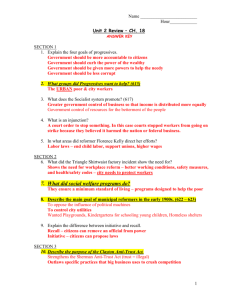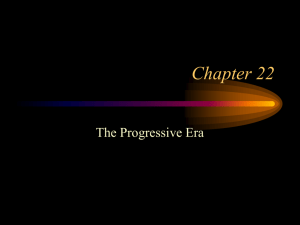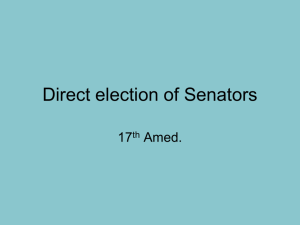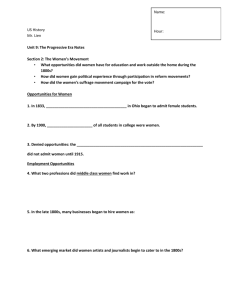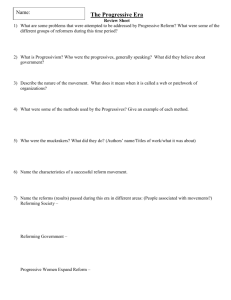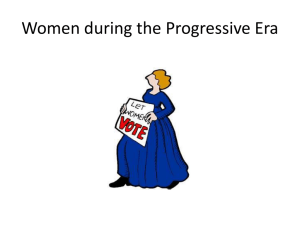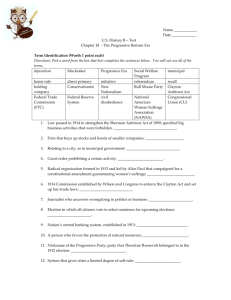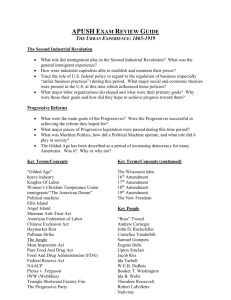The Progressive Era Notes Organizer: C.2 Increasing Influence and
advertisement
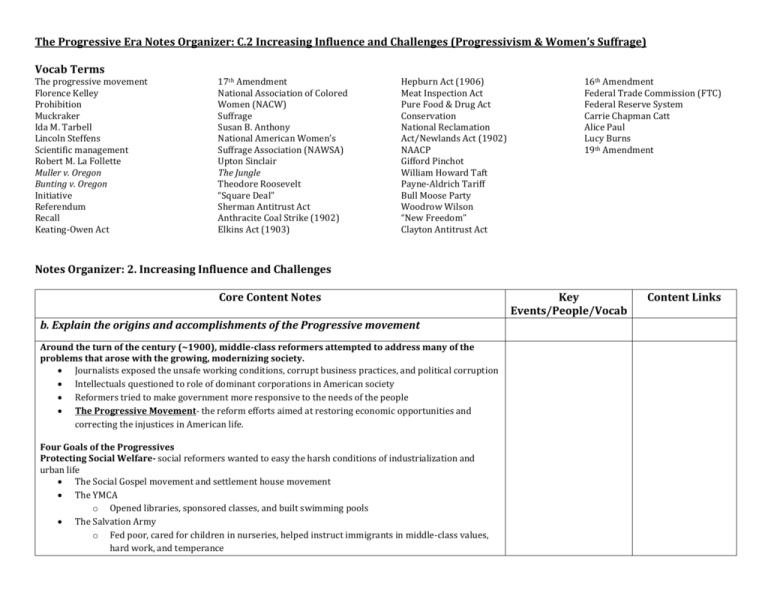
The Progressive Era Notes Organizer: C.2 Increasing Influence and Challenges (Progressivism & Women’s Suffrage) Vocab Terms The progressive movement Florence Kelley Prohibition Muckraker Ida M. Tarbell Lincoln Steffens Scientific management Robert M. La Follette Muller v. Oregon Bunting v. Oregon Initiative Referendum Recall Keating-Owen Act 17th Amendment National Association of Colored Women (NACW) Suffrage Susan B. Anthony National American Women’s Suffrage Association (NAWSA) Upton Sinclair The Jungle Theodore Roosevelt “Square Deal” Sherman Antitrust Act Anthracite Coal Strike (1902) Elkins Act (1903) Hepburn Act (1906) Meat Inspection Act Pure Food & Drug Act Conservation National Reclamation Act/Newlands Act (1902) NAACP Gifford Pinchot William Howard Taft Payne-Aldrich Tariff Bull Moose Party Woodrow Wilson “New Freedom” Clayton Antitrust Act 16th Amendment Federal Trade Commission (FTC) Federal Reserve System Carrie Chapman Catt Alice Paul Lucy Burns 19th Amendment Notes Organizer: 2. Increasing Influence and Challenges Core Content Notes b. Explain the origins and accomplishments of the Progressive movement Around the turn of the century (~1900), middle-class reformers attempted to address many of the problems that arose with the growing, modernizing society. Journalists exposed the unsafe working conditions, corrupt business practices, and political corruption Intellectuals questioned to role of dominant corporations in American society Reformers tried to make government more responsive to the needs of the people The Progressive Movement- the reform efforts aimed at restoring economic opportunities and correcting the injustices in American life. Four Goals of the Progressives Protecting Social Welfare- social reformers wanted to easy the harsh conditions of industrialization and urban life The Social Gospel movement and settlement house movement The YMCA o Opened libraries, sponsored classes, and built swimming pools The Salvation Army o Fed poor, cared for children in nurseries, helped instruct immigrants in middle-class values, hard work, and temperance Key Events/People/Vocab Content Links Florence Kelley- advocated improving lives of women and children o Helped win passage of the Illinois Factory Act (1893) which prohibited child labor and limited women’s working hours Promoting Moral Improvement- Felt morality was the key to improving the lives of the poor, and hoped to help people uplift themselves by improving their personal behavior Worked toward the goal of Prohibition- the banning of alcoholic beverages o Woman’s Christian Temperance Union (WCTU) spearheaded the crusade for prohibition o Women like Carry Nation would urge saloonkeepers to shut their doors, and even used her hatchet to destroy liquor and bars o The Anti-Saloon League (1895)- sought to close saloons to cure society’s problems. Often ran into problems with immigrant groups where drinking was part of their culture Creating Economic Reform- Following the Panic of 1893, some Americans questioned the capitalist economic system. Some workers and labor leaders embraced socialism o Eugene V. Debs organized the American Socialist Party in 1901, criticizing capitalism and the favorable treatment that big business often received from government and politicians ***Muckrakers were journalists who wrote about the immorality and greed of U.S. businesses and corruption in government. They hoped to expose socioeconomic problems in need of political attention. o Ida M. Tarbell described the ruthless business practices that helped John D. Rockefeller’s Standard Oil eliminate competing in her essay “History of the Standard Oil Company” in McClure’s Magazine o Lincoln Steffens published exposes of business and government corruption in his series of essays titled “The Shame of the Cities” and “The Struggle for Self-Government” Fostering Efficiency- Many progressives looked to scientific principles to make society and the workplace more efficient Used sociology to defend limiting work hours for women by documenting the high costs of long working hours for both the individual and society. Scientific management- studies by Frederick Taylor focused on time and motion to improve efficiency by breaking manufacturing task into simpler parts. o “Taylorism” became a fad as industrial reformers used these scientific management students to see how quickly each task could be performed The assembly line sped up production, but also caused high worker turnover, and led to injuries suffered by tired workers o Henry Ford reduced the work-day to 8 hours and paid his workers $5 a day, twice the average wage Cleaning Up Government- ***Progressives hoped to change government. To make it more democratic and more responsive to social issues. Reforming Local Government- While solving the problems of industrialization in the nation’s cities was one goal of the Progressives, they also sought to make government more efficient and responsive to social issues Commission System- Following the botched rebuilding effort by the Galveston, Texas city council after a devastating hurricane in 1900, The Texas legislature appointed a five-member commission of experts to take over. This prompted the city to adopt the commission system as a form of government o By 1917, 500 U.S. cities had adopted the commission system Council-Manager System- Following an flood in 1917, Dayton, OH adopted the council-manager form of government o People elect a city council to make laws o The council appointed qualified managers to run city departments o By 1925, nearly 250 cities had adopted the council-manager system Reform Mayors- Mayors instituted progressive reforms without changing how a city’s government was organized o Hazen Pengree of Detroit instituted a fairer tax system, lowered fares for public transportation, rooted out corruption, and set up a system of work relief for the unemployed o Other reform mayors focused on taking over utilities from corrupt and greedy private owners, converting the utilities into publically owned enterprises Reform at the State Level- many states passed laws to regulate railroads, mines, mills, telephone companies, and other large businesses Progressive Governors, like Robert M. La Follette of Wisconsin, worked to regulate big business La Follette served three terms as governor, and worked to drive business “out of politics and then treat them exactly like the same as other people are treated.” o Taxed railroad property the same as other business property o Set up a commission to regulate rates, and forbade RRs to issue free passes to state officials Protecting Working Children- As child labor grew, progressives worked to end child labor Florence Kelley and the Illinois Factory Act (1893)- Florence Kelley was an advocate for improving the lives of women and children o Helped to win passage of the Illinois Factory Act which banned child labor and limited women’s working hours within the state The National Child Labor Committee investigated the harsh conditions of child labor o Showed dramatic photographs and statistics to the public o Unions joined the NCLC claiming child labor lowered wages for all workers The Keating Owen Act (1916)- prohibited the transportation across state lines of goods produced with child labor o The Supremem Court declared the act unconstitutional, however… o Nearly every state passed legislation banning child labor and setting maximum hours for all workers Fighting for workplace reform- Progressives were successful in limiting work hours and securing benefits for workers hurt or killed on the job Muller v. Oregon (1908)- Louis D. Brandies argued that women required the state’s protection against powerful employers. o The Supreme Court upheld Oregon’s law limiting women to a ten-hour workday Bunting v. Oregon (1917)- The Supreme Court upheld the Oregon law limiting the workday to ten hours for men 1902- Maryland became the first state to pass laws requiring employers to pay benefits in death cases o other states followed Maryland’s lead and passed workers compensation laws Reforming State Elections- Starting with Oregon, states began to reform state governments, putting more power in the hands of citizens Initiative- A bill originating from the people, which is put on the ballot after citizens petition legislators Referendum- When voters accept or reject an initiative Recall- enables voters to remove elected officials by forcing them to face another election before the end of their term. o By 1920, 20 states had adopted at least one of these reform procedures Primary system- 1899, Minnesota became the first state to enable voters, instead of political machines, to choose candidates for political office through special elections Direct Election of Senators- The success of the direct primary led to a Constitutional amendment to make senators more responsive to the public. Before 1913, senators were chosen by each state’s legislature, putting considerable power in the hands of political machines and party bosses Seventeenth Amendment- Ratified in 1913, the 17th Amendment made the direct election of senators by the people of each state the law of the land c. Analyze the efforts to achieve women’s suffrage in the early twentieth century. Women Continue to Fight for Suffrage- The end of the Civil War brought about renewed demands for equal rights from the women of America. They would find that a united movement would be nearly as elusive as the franchise they hoped to secure. Constitutional Amendments and Tactics Split the Suffrage Movement ***Immediately following the Civil War, the ratification of the Fifteenth Amendment strongly influenced the women’s rights movement. Why? o The Fifteenth Amendment did not protect women from having their right to vote denied. o ***Susan B. Anthony, a leader in the women’s suffrage (the right to vote) movement, worked with Elizabeth Cady Stanton to form the National Women Suffrage Association (NWSA) o NWSA combined with another group in 1890 to form NAWSA, the National American Woman Suffrage Association ***The most significant split in the women’s suffrage movement was whether women seeking the right to vote should concentrate on the national or state level o The American Women Suffrage Association (AWSA) focused on the securing the vote at the state level o The NWSA and later NAWSA worked at the national level to secure a Constitutional amendment protecting women’s right to vote o ***The effort of suffragists to achieve reform at both the state and national level reflects a strategy based on the constitutional principle of federalism (the division of power between the states and national government A Three-part Strategy for Suffrage 1. Convince state legislatures to grant women the right to vote. o Wyoming territory granted women he right to vote in 1869, the first to do so. o ***By the 1890s, women had been given the right to vote in state and local elections in much of the western portion of the United States 2. Women filed court cases to test the Fourteenth Amendment, which declared that states denying their male citizens the right to vote would lose governmental representatives o 1871-72: Susan B. Anthony and others attempted to vote at least 150 times in ten states and the District of Columbia o 1875: The Supreme Court ruled that women were citizens BUT denied that citizenship automatically conferred voting rights 3. Women pushed for a national constitutional amendment for the right to vote o A representative from California was the first to propose an amendment for women’s suffrage in 1878. It was defeated in 1881. o Women would lobby to have it reintroduced for the next three decades, only to see it continually voted down. Teddy Roosevelt’s Square Deal- Roosevelt saw the presidency as a “bully pulpit” to influence and shape legislation that would curb business excess and see that the common American got a “square deal”. TR’s Square Deal- the various progressive reforms sponsored by the Roosevelt administration ***The purpose of the Square Deal was to promote policies beneficial to U.S. society as a whole, not just certain sectors TR the Trustbuster- While Roosevelt did not believe that all trusts/monopolies were harmful, he sought to curb the actions of those that hurt the public interest. TR ‘s administration filed 44 antitrust suits, winning many and breaking up some of the harmful trusts o ***He was guided by the idea that business monopolies were harmful to the public good o 1902- ordered the Justice Department to sue the Northern Securities Company, with had a monopoly over northwestern railroads o 1904- the Supreme Court dissolved the company TR and the 1902 anthracite coal strike- 140,000 Pennsylvania coal miners striked, demanding a 20% raise, a nine-hour workday, and the right to organize a union. The mine operators refused to negotiate. After five months, the nation’s coal reserves ran low Roosevelt called both side to the White House to negotiate an end to the strike Furious with the mine operators unwillingness to bend, TR threatened to use federal troops to take over the mines o The opposing sides agreed to arbitration (a third party to mediate the dispute) o 1903- the arbitration commission issued its compromise: the miners won a 10% raise and a nine-hour work day, but they had to give up their demand for a union and their right to strike for three years o TR’s actions reflected the progressive belief that disputes could be settled in an orderly way, and when a strike threatened the public welfare the federal gov. was expected to intervene. Railroad Regulation- Roosevelt pushed for federal regulation over businesses such as the railroads. He urged Congress to pass laws to strengthen the Interstate Commerce Commission. Elkins Act (1903)- made it illegal for railroad officials to give, and for shippers to receive, rebates for using certain railroads. o Also said RRs could not change set rates without notifying the public Hepburn Act (1906)- strictly limited the distribution of free railroad passes. o Gave the ICC power to set maximum railroad rates. Regulating Food and Durgs- After reading Upton Sinclair’s The Jungle, a book exposing the shocking conditions of the meatpacking industry, Roosevelt pushed for passage of regulatory laws to clean up the industry. Meat Inspection Act (1906)- Dictated strict cleanliness requirements for meatpackers and created a program of federal meat inspections Following a series of lectures by Dr. Harvey Washington, chief chemist at the Department of Agriculture, regarding harmful preservatives to food and deadly ingredients in medicines, TR pushed for regulation of the food and drug industry. Pure Food and Drug Act- Halted the sale of contaminated foods and medicines o Called for truth in labeling so consumers would be given accurate information to make wise decisions Conservation and Natural Resources- In the late 19th century, Americans had exploited their natural resource to extremes. Farmers leveled forests and plowed up the prairies. Ranchers allowed cattle to overgraze the Great Plains. Lumber companies over-logged forests leading to flooding, while failing to replant trees. Conservation Measures- Roosevelt worked toward sensible conservation- that meant some wilderness areas would be preserved, while others would be developed for the common good. Set aside 148 million acres of forest reserves Set aside 1.5 million acres of water-power sites Set aside 80 million acres of land to explore for mineral and water resources Established more than 50 wildlife sanctuaries and several national parks Named Gifford Pinchot as head of the U.S. Forest Service. o Pinchot was a professional conservationist. He advised Roosevelt to conserve forest and grazing lands by keeping large tract of federal land exempt from private sale National Reclamation Act (Newlands Act) of 1902-Set aside money from the sale of public lands in the West to fund large-scale irrigation projects o Set the precedent of the federal gov. managing the water resources of the west
